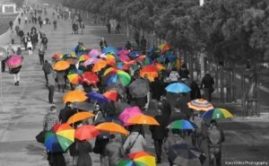Overview • Galleries (See Galleries) • Monthly Themes • Field Trips • Speakers • Projects
OPC Themes for 2022
Thematic collections of photographs can help keep conversations about the artwork “on topic.” The collection may then elicit different impressions, identifications of technique, and artistic assessments from each viewer of each photograph. Sharing those impressions, techniques and assessments can be a first step toward improving our technical and artistic skills, as well as helping develop the “art of seeing,” as Freeman Patterson would say.
January Enjoying Food.
February Two Things.
March Open (changed from Choose a Color or Two).
April Macro/Close-up.
May Environmental Portrait.
June Long Exposure.
July Monochrome.
August Flowers.
September Night.
October Open, No Time Limit (was Abstracts).
November Architectural Photography.
December Generations.
OPC Themes for 2021
Thematic collections of photographs can help keep conversations about the artwork “on topic.” The collection may then elicit different impressions, identifications of technique, and artistic assessments from each viewer of each photograph. Sharing those impressions, techniques and assessments can be a first step toward improving our technical and artistic skills, as well as helping develop the “art of seeing,” as Freeman Patterson would say.
January Open.
February Creative Technique.
March Life during COVID.
April Motion.
May Trees.
June Reflections.
July Pets.
August No Meeting.
September Gardens.
October Panoramas.
November Water.
December Look Up / Look Down.
OPC Themes for 2020
Thematic collections of photographs can help keep conversations about the artwork “on topic.” The collection may then elicit different impressions, identifications of technique, and artistic assessments from each viewer of each photograph. Sharing those impressions, techniques and assessments can be a first step toward improving our technical and artistic skills, as well as helping develop the “art of seeing,” as Freeman Patterson would say.
January Circles. In the mechanical world, circles are strong. Aside from making a great wheel, a semi-circle makes a perfect arch support for heavy structures. As a compositional frame, the circle is also strong. It draws the eye towards the middle of the frame and concentrates your attention. Far more than the rectangle or square, a circle suggests security and finite limits, yet despite the strength of the circle it can also offer a look that is soft, organic, and inviting. It always makes a definite statement about the contained image. Read these articles for more ideas.
https://petapixel.com/2016/12/05/seeing-circles-compose-circular-photograph/
https://digital-photography-school.com/weekly-photography-challenge-circles/
February Doors and Windows. There is something about doors and windows. Doors and windows tell us so much about the streets, about history, about culture—and they’re everywhere. Doors and windows are big, small, plain, colorful, old, new, modern, and antique, they come in all shapes and forms. Sometimes you will find open doors and windows, sometimes closed, with or without people, and sometimes the door or the windows are gone, but you know where they used to be. Read this article for ideas.
https://www.picturecorrect.com/tips/window-and-door-photography-tips/
March Winterscapes. Winterscape explores the relationship between forms, content and visual flow in the context of the landscape. The visual material includes studies of snow, ice, water, sky and mountains that play out across a range of scales - from the wide expanses of the mountain landscapes to the equally rich visual pleasures of the finer details of snow, rock, ice and water. The white of the snow captures the play of light and form. The soft texture of snow and water is at the same time reinforced by the flow of sky and cloud, and held in sharp counterpoint by the weight and contours of the mountains themselves. Rivers and waterfalls form an arena for an ongoing struggle between the lively freedom of the moving water and the crystalline cage of intricate and delicate ice formations. We may not have snow in Virginia but you will be able to find some landscape indicative of winter.
https://www.outdoorphotographer.com/tips-techniques/nature-landscapes/tips-for-winter-photography/
April Clouds. Cloudscape photography is photography of clouds or sky. In the early to middle 20th century, American photographer Alfred Stieglitz (1864–1946) created a series of photographs of clouds, called "equivalents" (1925–1931).

Carry your camera everywhere with you and always make a point to look up to the sky as you go about your daily routine. If the clouds are doing something interesting. Take a picture of them.
May National Parks. Washington, DC, is where history happens! Do you want to recreate in a natural environment? Explore historic buildings and landmarks? Celebrate in a major festival? You'll find it all here. There are over 50 NPS locations in the National Capitol region.
After you take your image consider entering the Share the Experience Photo Contest. The Share the Experience Photo contest is a special opportunity for outdoor enthusiasts to share their love of parks, beautiful views, unique finds, and hidden treasures of America's national parks. The contest is hosted in partnership with six participating federal agencies, the National Park Service, the Bureau of Land Management, the Bureau of Reclamation, the U.S. Fish and Wildlife Service, the U.S. Forest Service, the U.S. Army Corps of Engineers, and Recreation.gov.
Check these websites out for more inspiration.
https://www.sharetheexperience.org/home
https://www.nps.gov/locations/dc/index.htm
June Strange Signs. Signs can be interesting and/or funny in their own right and they can give the person who's viewing your work more information about the areas you visited too. Older parts of towns will have signs that look a little more battered while newer signs which look less worn and more modern will suggest you spent quite a lot of time in newer areas of town. They also suggest if you've ventured beyond the tourist areas as signs tend to just have the language of the country you're visiting once you're over the edges of the tourist trap. These in particular are the signs that can be funny too due to the different language or images used to illustrate what the signs telling people. You may also find people have added their own diagrams to the signs which can often bring to odd grin or two.
https://www.ephotozine.com/article/tips-on-photographing-signs-on-your-travels-16967
https://expertphotography.com/photograph-neon-signs/
July Monuments or Memorials. The problem with photographing famous landmarks is just that - they're famous. So famous in fact that even if you're never visited the Leaning Tower of Pisa, or the Sydney Opera House, or the Pyramids, you've probably seen so many photos of them that it feels like you have.
As photographers this presents us with a unique challenge - finding a new angle or creative viewpoint that avoids clichés and shows off the landmark in a way that people are not so familiar with, and perhaps have never seen before.
This is tricky but it can be done. The key is to take a step back and see the landmark through fresh eyes, rather than being influenced by what we've seen before. Use the following tips to avoid the tried-and-tested shots and capture something more original and intriguing. Read this article for suggestions.
https://www.photographymad.com/pages/view/7-landmark-photography-tips-for-avoiding-cliched-photos
August No Meeting.
September Umbrellas. Umbrellas have something that makes them extremely photogenic. Colorful and whimsical, they are so beautiful to photograph that they might even be considered a cliché for some photographers. Check out the link below to read more about photographing in the rain.


https://www.nationalgeographic.com/photography/photo-tips/taking-photos-in-rain-richardson/
October Books. It's no secret that book lovers are obsessed with bookstagram. Endless accounts filled with feeds that are dedicated solely to photographing, discussing and celebrating books is any bibliophile's dream come true. And while you could just plunk a book down anywhere and snap a quick pic of it, bookstagrammers have perfected the art of the beautiful book photo. YA, adult, crime, thriller, horror, romance... every genre under the sun is represented on bookstagram, and no one account is the same.
November Feathers. The beautiful designs and colors that can be found in the feathers of many species of birds offer wonderful photo opportunities. You can create frame-filling shots of unique patterns, and it’s also possible to make interesting arrangements of the feathers that become a unique art form unto itself.
https://www.shutterbug.com/content/feathers-beauty-birds-close
https://www.adorama.com/alc/0014412/article/how-to-shoot-a-backlit-feather
December Leading Lines. Leading lines are one of the most powerful tools for creating high impact photos. When used correctly, they add wonderful depth by drawing the eye deep into the image. Check this website out for ideas:
https://expertphotography.com/how-to-use-leading-lines-to-improve-your-composition/
OPC Themes for 2019
Thematic collections of photographs can help keep conversations about the artwork “on topic.” The collection may then elicit different impressions, identifications of technique, and artistic assessments from each viewer of each photograph. Sharing those impressions, techniques and assessments can be a first step toward improving our technical and artistic skills, as well as helping develop the “art of seeing,” as Freeman Patterson would say.
January Hands. The fun of photography is the ability to tell a story through pictures. The ability to freeze time and capture moments, memories, and images that express emotion and feeling. Though we are often drawn to the eyes of the subject, there is nothing more powerful than the stories that can be told by a person’s hands.
As humans we use our hands to talk, weave stories with our hands through pencil and paper, we cry into our hands, use them to show love, and affection, to climb mountains, and to stifle laughter. What more could you ask for when capturing a subject for a photo then one full of chapters ready to share?
February See Red. We don’t know if Cupid really loves red, but since we’re ambushed with the color in February in celebration of Valentine’s Day, we ought to photograph it. Red is famously one of the most difficult colors to capture authentically on film, especially in natural lighting.
Red symbolizes passion, fire, love and anger. In Eastern cultures, it connotes luck and prosperity. Red occurs throughout nature, from dying stars to dying leaves, and humans have evoked its powers for everything from politics to sports.
March Disappearing Technologies. An increasing number of millennials have never used a landline, worn an analog wristwatch, or mailed a handwritten letter. They do not learn art and design technologies that previous generations took for granted. The scope of digital technology has made many things obsolete, from traditional black-and-white film to the tape cassette, but they have not disappeared completely. In the hands of artists and designers, a bygone technology can take on a new significance. What’s your disappearing technology?
April Self-Portrait. It is surprising how many photographers are reluctant to turn the cameras on themselves, but some of the world's most famous photographers have done just that. Using yourself as your model doesn't necessarily mean a seated portrait, but is more an excuse to experiment with poses, costumes, and artistry with the only model you'll ever have who won't complain. It helps to use a tripod and shutter release, rather than limiting yourself by trying to photograph with the camera at arm’s length. You decide how you want to show yourself to the world!
May Emotion. One thing that makes a great photo is its ability to convey emotion and thus connect with the viewer. Happiness and joy, sorrow and despair, these are some of the easier emotions as they are universally felt, at one time or another, by everyone.
Emotion, or a feeling, is what can bring a snapshot out of obscurity and make it shine. Think of a normal sunset picture from the shores of Hawaii with just the horizon and a bright orange sun dipping low. It’s beautiful for sure and even better when viewed in person. Now pull the zoom back to a wider angle and show a couple in silhouette, sitting on lounge chairs facing the waves and reaching to each other to hold hands. Different people will connect with each photo in different ways, or maybe not at all. Those in a romantic mood will enjoy the photo of the couple and those looking for calm without distraction may enjoy the singular sunset.
June Black and White. One of the most common reasons people want to make black and white photos today is because it lends a certain timeless quality to the images. While the “when” and “why” are related, photographing in color and then wondering whether to convert the image employs a very different mindset from setting out and seeing the world in black and white, and then working within those confines. Parameters of a world without color forces you to see things differently, to stretch and work out your photographic eye muscles, and that in turn pushes you creatively.
Focus on composition and lighting, the two strongest elements of a black and white photograph. These are important because black and white composition does away with the distraction of color. Suddenly elements within the frame can relate in a way that might otherwise have been throw off because of jarring color.
July Abstracts. Abstraction, in general, is a process by which some information is carefully eliminated leaving the parts that deemphasize the object-photograph relationship. For instance, get a sheet of paper and a pen, put your hand with fingers slightly separated, and draw an outline of your hand.

You now have just the outline information, the shape of your hand, by eliminating the skin texture, color, depth, form, etc. It has no fingerprints! This is how abstraction in general works, we leave some information behind and keep the parts we want to include in the photograph. The outline you have just drawn is “just a hand” not necessarily your hand, breaking the linkage between the subject and the image drawn.
August No Meeting Scheduled.
September Photograph a Stranger. It doesn’t matter what you say to people, the most important aspect of approaching people to photograph tem is being genuine, warm, friendly and calm. People will read your body language before you open your mouth, so if you come off as tense they will probably think you are shifty. If you are not smiling, people are going to think you’re unfriendly. Of course being a bit nervous is natural. It’s totally normal. But the more you practice, the calmer you’ll become. Then you’ll settle into yourself more, get a little pattern going and it’ll be much easier. It doesn’t matter much what you say, how you say it, or what you are working on, how people react to you is almost 100% because of your body language and the feelings you have when you approach them.
You must be quick and be prepared. Don’t fumble with removing a lens cap, changing settings on the camera or putting down a camera bag. Remember, the best street photographers spend the majority of time immersed in society, seeking out their subject, and so should you.
October Still Life. When most of us think of a still life photo, we generally think of a created still life where we build the entire composition–from choosing the most photogenic bowl, to what fruit to use, to how to position and light all the other elements.
When you walk your favorite trail and run across a fallen leaf sitting on a particularly attractive rock, that’s a still life, too. If you photograph it as is, without making any adjustments, it’s a found still life.
When photographing a still life subject, you are creating an image rather than capturing a moment. You are constructing your photograph; from background, to subject, to lighting. With the subject matter being inanimate objects, their tendency to stay very still allows you to take time to refine your lighting, and experiment with your composition. It’s a very pleasant way to photograph, and you don’t need any fancy gear. It’s also a great way to learn about lighting and composition, the key elements to any photographic style.
November Play with Liquids. [Inserted 20191106] Play with liquid and the possibilities are endless. Different colored water, paints, and oils all create interesting patterns and shapes that can easily be captured, even in small spaces. Or, get up close and macro with a single water drop. When you stop to think about how liquid reflects light and changes form, you'll see how endless the possibilities really are.
(The following text was incorrectly placed with the "Play with Liquids" theme. It came from the November 2018 theme "Have Fun with It.") When you are photographing a mundane object, you don’t need to worry about it growing tired of posing, so have fun with this project and take as much time as you need. Try different angles, lie on the ground, climb up on something, do whatever it takes to snap pictures that transform ordinary into extraordinary. For more inspiration, pay attention to other photographers when you are out at a popular attraction and observe their positions. Try mimicking their positions to see what they are seeing because even if you look odd, the great photographs you take are worth it.
December Things Neatly Organized, or “Knolling Photography.”“Knolling photography” (Google it to find out more) involves photographing objects grouped together and arranged neatly, either parallel or at right angles to one another. The look of the resulting image can be quite clean and clinical - as opposed to a jumble of items, everything is neatly laid out.
The technique is very useful whenever you want to photograph a group of items, with each item clearly identifiable. Knolling is often used for sharing an image of the contents of a bag. But, of course, it can be used for other things too, such as the ingredients for a meal, clothes that form an outfit, a small book collection, or just a collection of related items you think would work well for a knolling photo.
Before you start laying your items out, think about the background you will lay them out on. You want something that is quite plain and does not distract from the items. Importantly, it also needs to be large enough for you to fit all the items on in a neat arrangement. Here is an example.

Knolling can be very useful to obtain a pleasing image when photographing a group of items that could otherwise be a bit boring. Why not give it a try, photographing the contents of your handbag, your camera bag, or the ingredients for a home-cooked dinner?
OPC Themes for 2018
Thematic collections of photographs can help keep conversations about the artwork “on topic.” The collection may then elicit different impressions, identifications of technique, and artistic assessments from each viewer of each photograph. Sharing those impressions, techniques and assessments can be a first step toward improving our technical and artistic skills, as well as helping develop the “art of seeing,” as Freeman Patterson would say.
January Vintage Items. Do you have an object at home that you want to photograph to save the memory before you downsize? Ever been to an outdoor antique market and wish you could buy that antique thingamajig – photograph it instead to preserve the memory.
February Toys: Show Us Your Inner Child. You’re looking for some fun photography ideas and your toys are just looking for some fun. Give your toys the life they deserve. Put them in the scenes they were meant to be in. Tractors and gorillas don’t belong on a shelf. Dolls should have a tea party. Look at your stuff and determine where each item is supposed to be. Then, go to that place and give your stuff what is wants: a life far removed from the humdrum life of shelfdom.
March Vintage Signs. Do some research and see how many old signs from decades past remain. Try capturing unique or interesting signs of any age.
April Curves. Curves make an image easy to look at by leading the viewer’s eye through the frame. It is almost as if the photographer takes the viewer by the hand, draws them into the landscape, and points the way. The viewer’s eyes are compelled to follow the line.
Curves are graceful, rhythmic, and dynamic and add energy to an image. They can separate or connect elements or simply offer a balance.
C curves, or semi-circles, are probably the easiest curves to find since almost any curves qualify. They can be anything from the gentle curve of a seashore, lakeshore, a rounded rock, or grasses blowing in the wind.
May Man-altered Landscapes. Rather than making an image of a traditional landscape, look for a shot that shows how man has altered his surroundings. Is it a canyon of skyscrapers, footprints in the sand, a fence?
June Animals. If you have gone on a safari great – you probably have some fantastic wild animal images. Please don’t feel like you have to go on safari to capture a great animal image. Your pet might prove the perfect subject. Small animals or birds in the park are equally great. Focus on the eyes, get the fur sharp. Another great macro opportunity.
July I Love a Parade. Get physically close to the people you are photographing. Let them see that you are taking their photo which allows interaction with them if only by eye contact. They know they’re on display in the parade and expect to have their photo taken many times. If you are otherwise hesitant or tentative photographing people this is a perfect opportunity because you have a whole stream of willing subjects literally parading in front of you (sorry – pun intended). Sometimes you’ll get a great reaction when they see your camera. Parades can be visually stimulating, and overly busy so getting in closer will help solve those problems. Pick one person, or one part of a float and get closer.
August No Meeting Scheduled.
September Weather. Capture an identifiable facet of weather (storm clouds, rain, snow, use your imagination.)
October Fall Colors. Fall is a photographer’s dream season. It’s the time when nature explodes with color and misty mornings are whispering “Hey look at me, wouldn’t I make just the most amazing photograph?” Go our early enough to catch dew on a colored leaf or a misty reflection.ind of weather there is, and where the sun positioned in the frame.
November Have Fun with It. When you are photographing a mundane object, you don’t need to worry about it growing tired of posing, so have fun with this project and take as much time as you need. Try different angles, lie on the ground, climb up on something, do whatever it takes to snap pictures that transform ordinary into extraordinary. For more inspiration, pay attention to other photographers when you are out at a popular attraction and observe their positions. Try mimicking their positions to see what they are seeing because even if you look odd, the great photographs you take are worth it.
December Open.
Overview • Galleries (See Galleries) • Monthly Themes • Field Trips • Speakers • Projects